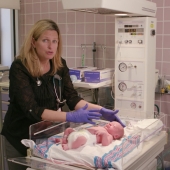Whether your Cesarean Section was scheduled or unexpected, it's helpful to know about the process ahead of time. In this video, we'll discuss:
Why a Cesarean Section might be needed, what to expect during your Cesarean Section, and what it means to have a gentle Cesarean Section. There are many reasons why a patient may need a Cesarean Section.
There may be factors identified during your prenatal care that prompt your provider to recommend a Cesarean Section.
Such as a placental abnormality, or if the baby is not positioned head down. Alternatively, it may become indicated during labor if there is a concerning pattern on the fetal heart rate tracing, which is a monitor used to access the babies well being during labor.
Another indication is if there is not sufficient dilation of the cervix, or if the baby does not seem to be descending normally through the pelvis. Your provider will fully inform you of the risks, benefits, and reason for your Cesarean Section.
You will meet anesthesiologist who will be caring for you during your procedure. Most Cesarean Sections will be performed with regional anesthesia. Meaning that you will be awake, but be given an injection in to your back, also called a block, that prevents you from feeling pain during the surgery.
You'll be brought back to the operating room where you will be prepared for surgery. After your block is placed, your team will place a urinary catheter to drain your bladder, as well as prepare the sterile field and drapes.
Everything in your surgery will be done using careful, sterile protocol to ensure that your risk of infection is minimized. And you will be given breast feeding safe antibiotics to further reduce your risk of infection.
When everything is ready, your chosen support person will be escorted in to the room to be with you at the head of the bed. You may feel pressure, pulling, or a stretching sensation during the operation, but you will not feel anything sharp.
Upon delivery of your baby, there will be a window in the curtain that is opened. Or the drape will be lowered so that you can see your baby in the first moments after birth.
The pediatrics team will then assess your baby, and if there are no complications, or additional care needed, will bring him or her over to you.
Many hospitals now practice gentle Cesarean Section. Where the focus is on reuniting the mom and baby as soon as possible. Here at UC San Diego Health we routinely bring baby back to mom on the operating room table right away. And if she feels well enough, help her put baby skin to skin, or hold her baby.
Some patients even start nursing while the Cesarean Section is being completed. Other components of a gentle Cesarean Section may include classical music and dimmed lights. Aside from the operating lights, of course.
Recovery for a Cesarean Section does take longer than for a vaginal delivery. Immediately after your Cesarean Section, you will be in a special post-operative recovery room for a few hours before moving to your private postpartum room with your baby.
Most women will spend three nights in the hospital after a Cesarean Section, and will require pain medications containing a small amount of opioids. It will still be safe to breast feed.
Sometimes it takes slightly longer for your milk to come in after a Cesarean Section. Your lactation team will help support you and your baby to meet your breast feeding goals during this transition.
Once you are home, recovery will continue for four to six weeks. Avoiding lifting anything heavier than 15 pounds during this time is important to help your body to heal.
It's important to ask questions or voice any concerns or requests that you have before, during, or after your Cesarean Section. Your treatment team cares that your experience is as smooth as possible with the ultimate goal of healthy mom and healthy baby.
- 3258 views













